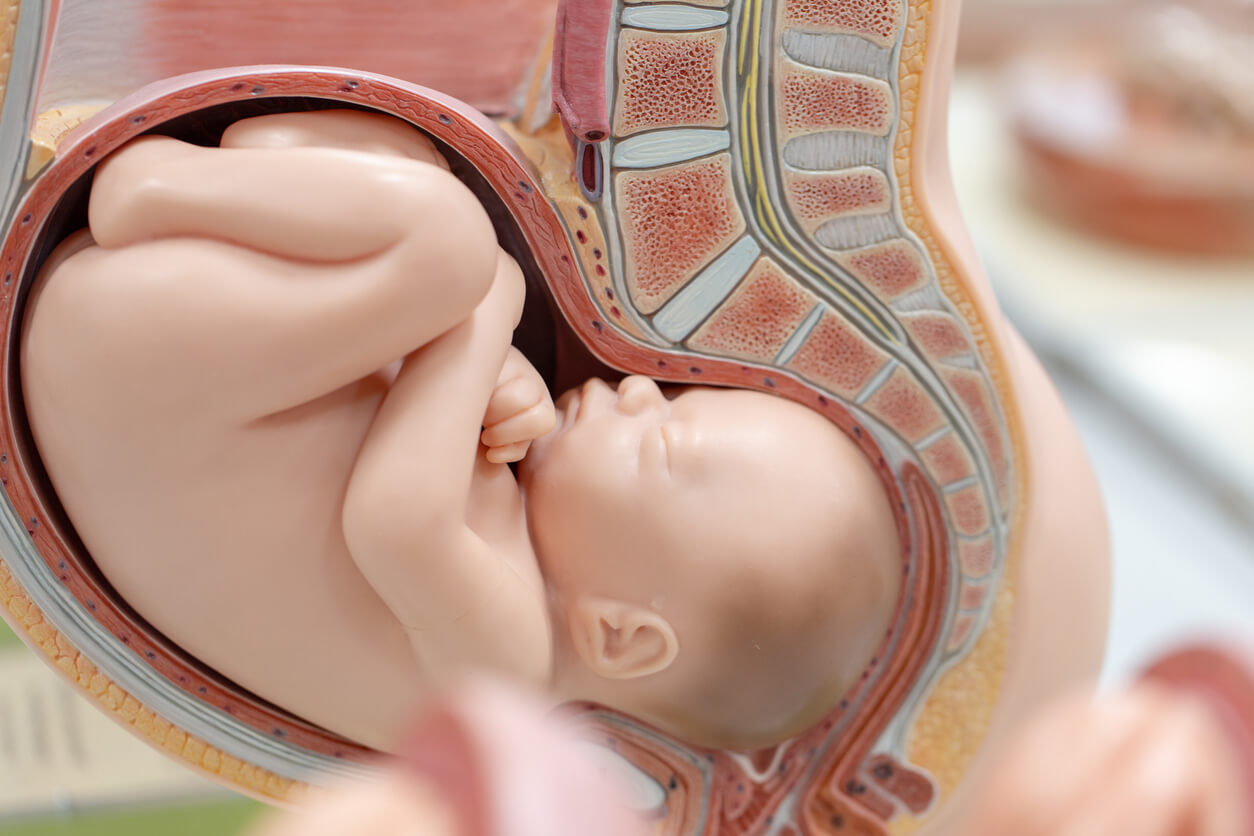8 Signs that Labor Is Approaching


Written and verified by the nurse Leidy Mora Molina
The last weeks of pregnancy are usually accompanied by joy, anxiety, and the worries that are typical of this final stage. In the midst of so many emotions, new bodily sensations appear that indicate that labor is approaching. Do you know how to identify them? Here are some signs that precede the long-awaited encounter.
1. The baby’s descent
One sign that labor is approaching is when your baby descends and enters the maternal pelvis, that is, the birth canal. This happens in the last weeks of gestation, thanks to the fact that the baby has gained considerable weight and the uterus has changed its shape for the final stretch.
This event indicates that labor is near, but it can happen in the following days or weeks. The good news is that the baby has already adopted a suitable position to come out of the womb.
After the descent, it’s normal to experience some mild pain or pressure in this area and in the perianal area. But in return, you’ll notice that you can breathe more freely and you will feel that your stomach is less pressured than in previous weeks.
2. Expulsion of the mucus plug
The mucus plug is a thick secretion that forms in the cervix from the first weeks of pregnancy. It seals the entrance to the cervix and keeps the baby safe from germs that live in the mother’s vagina.
As labor approaches, the cervix begins to soften and shorten, causing the mucus plug to fall out and be removed. As a result, you’ll notice that your underwear becomes soiled with a thick, heavy, clear discharge with thin brown or bloody threads.
The loosening of the mucus plug isn’t painful, nor does it indicate that labor is imminent. In fact, it’s usually accompanied by a copious discharge, the leakage of which continues for a few days before birth.

3. Pelvic and back pain
Aches and pains in the lower abdomen and back are quite common throughout pregnancy. However, as labor approaches, they intensify. False contractions, which become more and more frequent, the baby wedged in the pelvis, and the distension of the uterine tissues predispose mothers to increased pain.
It’s normal to feel the discomfort in the belly radiating down the spine and into the pelvis and even making it difficult to walk or move around normally.
4. Vaginal spotting
Another clue that indicates that labor is approaching is vaginal spotting. It’s normal that in the previous days the discharge becomes abundant and becomes more brownish or pinkish. In general, this is odorless and appears after minimal trauma, such as sexual intercourse or gynecological examinations.
If the leakage is scanty and isn’t accompanied by other symptoms, you shouldn’t worry, as it’s probably the product of cervical modifications.
On the contrary, if you notice that the bleeding becomes abundant and appears in the context of severe pain or general malaise, go to the clinic to be evaluated as soon as possible.
5. Contractions
A few weeks before delivery, it’s normal to experience Braxton Hicks contractions (or “false contractions”) more frequently. This occurs to prepare the uterus for labor.
False contractions aren’t painful and only in some cases may be accompanied by mild discomfort. They’re also irregular and last less than a minute. They appear when you’re active, when the baby moves frequently, or after sexual intercourse.
In contrast, true labor contractions are intense, frequent, and regular. You’re not going to lose sight of them, as the pain they arouse will prevent you from maintaining your activity.
Read also: 6 Types of Contractions
6. More frequent urination
As your pregnancy progresses, you’ll notice an increase in the frequency of urination, both day and night. However, in the days leading up to delivery, these trips to the bathroom will become even more frequent.
This occurs because the baby is wedged inside the pelvis, which generates greater pressure on the bladder and makes it impossible to distend it for proper filling. Because of this, it’s normal that when you go to the bathroom, only a small amount of pee comes out.
7. Muscle cramps
Muscle cramps become frequent in the weeks before delivery, also as a result of the pressure of the uterus on the pelvic area. The wedged baby’s head presses on the veins and nerves that run through the pelvis, which promotes fluid retention in the legs and the development of cramps.

8. Feelings of fatigue
In the days leading up to delivery, it’s normal to feel increased fatigue. The weight of the belly is considerable and this limits movement. In addition, the night’s rest is often insufficient and sleep is of poor quality. This happens because of physical symptoms (reflux, cramps, heaviness) and also, because of psychological aspects (anxiety, uncertainty, among others).
Contrary to this, some women experience extra energy, which is known as nesting. In this situation, the mother feels the need to clean, tidy and arrange everything in the home for the baby’s early arrival.
Is labor approaching or has the day finally arrived?
The signs we have shared with you indicate that your body is ready to receive your baby. However, labor won’t begin until your water breaks and real contractions start.
To reduce anxiety and better manage stress, it’s best to clarify all your doubts with your obstetrician or midwife during the last check-ups of your pregnancy. They’ll be able to guide you in the most appropriate way, based on your experience and recommendations based on science.
The last weeks of pregnancy are usually accompanied by joy, anxiety, and the worries that are typical of this final stage. In the midst of so many emotions, new bodily sensations appear that indicate that labor is approaching. Do you know how to identify them? Here are some signs that precede the long-awaited encounter.
1. The baby’s descent
One sign that labor is approaching is when your baby descends and enters the maternal pelvis, that is, the birth canal. This happens in the last weeks of gestation, thanks to the fact that the baby has gained considerable weight and the uterus has changed its shape for the final stretch.
This event indicates that labor is near, but it can happen in the following days or weeks. The good news is that the baby has already adopted a suitable position to come out of the womb.
After the descent, it’s normal to experience some mild pain or pressure in this area and in the perianal area. But in return, you’ll notice that you can breathe more freely and you will feel that your stomach is less pressured than in previous weeks.
2. Expulsion of the mucus plug
The mucus plug is a thick secretion that forms in the cervix from the first weeks of pregnancy. It seals the entrance to the cervix and keeps the baby safe from germs that live in the mother’s vagina.
As labor approaches, the cervix begins to soften and shorten, causing the mucus plug to fall out and be removed. As a result, you’ll notice that your underwear becomes soiled with a thick, heavy, clear discharge with thin brown or bloody threads.
The loosening of the mucus plug isn’t painful, nor does it indicate that labor is imminent. In fact, it’s usually accompanied by a copious discharge, the leakage of which continues for a few days before birth.

3. Pelvic and back pain
Aches and pains in the lower abdomen and back are quite common throughout pregnancy. However, as labor approaches, they intensify. False contractions, which become more and more frequent, the baby wedged in the pelvis, and the distension of the uterine tissues predispose mothers to increased pain.
It’s normal to feel the discomfort in the belly radiating down the spine and into the pelvis and even making it difficult to walk or move around normally.
4. Vaginal spotting
Another clue that indicates that labor is approaching is vaginal spotting. It’s normal that in the previous days the discharge becomes abundant and becomes more brownish or pinkish. In general, this is odorless and appears after minimal trauma, such as sexual intercourse or gynecological examinations.
If the leakage is scanty and isn’t accompanied by other symptoms, you shouldn’t worry, as it’s probably the product of cervical modifications.
On the contrary, if you notice that the bleeding becomes abundant and appears in the context of severe pain or general malaise, go to the clinic to be evaluated as soon as possible.
5. Contractions
A few weeks before delivery, it’s normal to experience Braxton Hicks contractions (or “false contractions”) more frequently. This occurs to prepare the uterus for labor.
False contractions aren’t painful and only in some cases may be accompanied by mild discomfort. They’re also irregular and last less than a minute. They appear when you’re active, when the baby moves frequently, or after sexual intercourse.
In contrast, true labor contractions are intense, frequent, and regular. You’re not going to lose sight of them, as the pain they arouse will prevent you from maintaining your activity.
Read also: 6 Types of Contractions
6. More frequent urination
As your pregnancy progresses, you’ll notice an increase in the frequency of urination, both day and night. However, in the days leading up to delivery, these trips to the bathroom will become even more frequent.
This occurs because the baby is wedged inside the pelvis, which generates greater pressure on the bladder and makes it impossible to distend it for proper filling. Because of this, it’s normal that when you go to the bathroom, only a small amount of pee comes out.
7. Muscle cramps
Muscle cramps become frequent in the weeks before delivery, also as a result of the pressure of the uterus on the pelvic area. The wedged baby’s head presses on the veins and nerves that run through the pelvis, which promotes fluid retention in the legs and the development of cramps.

8. Feelings of fatigue
In the days leading up to delivery, it’s normal to feel increased fatigue. The weight of the belly is considerable and this limits movement. In addition, the night’s rest is often insufficient and sleep is of poor quality. This happens because of physical symptoms (reflux, cramps, heaviness) and also, because of psychological aspects (anxiety, uncertainty, among others).
Contrary to this, some women experience extra energy, which is known as nesting. In this situation, the mother feels the need to clean, tidy and arrange everything in the home for the baby’s early arrival.
Is labor approaching or has the day finally arrived?
The signs we have shared with you indicate that your body is ready to receive your baby. However, labor won’t begin until your water breaks and real contractions start.
To reduce anxiety and better manage stress, it’s best to clarify all your doubts with your obstetrician or midwife during the last check-ups of your pregnancy. They’ll be able to guide you in the most appropriate way, based on your experience and recommendations based on science.
All cited sources were thoroughly reviewed by our team to ensure their quality, reliability, currency, and validity. The bibliography of this article was considered reliable and of academic or scientific accuracy.
- American Pregnancy Association (2021). Señales del parto. Recuperado de: https://americanpregnancy.org/es/healthy-pregnancy/labor-and-birth/signs-of-labor/
- Asociación Española de Matronas. (2017). Los consejos de tu matrona. España Recuperado de: https://aesmatronas.com/wpcontent/uploads/2018/01/Los-consejos-de-tu-matrona.pdf
- Carvajal, J. (2018). Manual de Obstetricia y Ginecología. Chile. 9na Edición.
- Cunningham, F. et al (2015) Capítulo 22: Trabajo de parto normal. Williams. Obstetricia, 24e McGraw Hill. Recuperado de: https://accessmedicina.mhmedical.com/content.aspx?bookid=1525§ionid=100455028
- Mayo clinic (2021). Trabajo de parto y parto, cuidado de posparto. Recuperado de: https://www.mayoclinic.org/es-es/healthy-lifestyle/labor-and-delivery/in-depth/signs-of-labor/art-20046184
- Monzón, L. et al (2017). Calambres musculares benignos y embarazo. Revista portales médicos. Recuperado de: https://www.revista-portalesmedicos.com/revista-medica/calambres-musculares-benignos-embarazo/
This text is provided for informational purposes only and does not replace consultation with a professional. If in doubt, consult your specialist.








